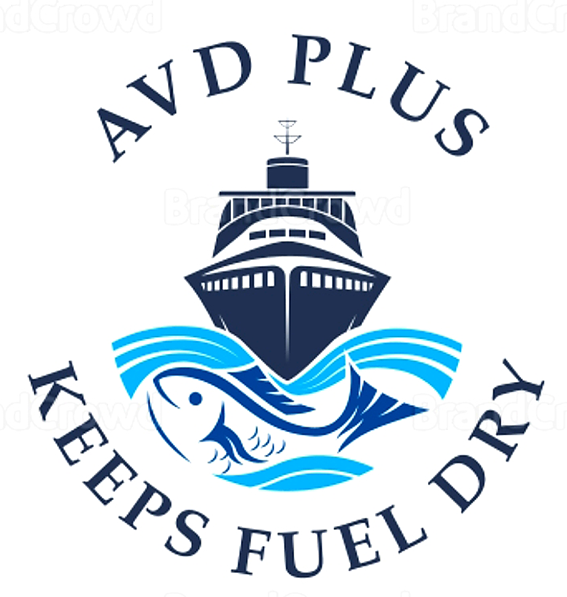Follow Us x
Fuel Guards
Air Vent Dryers
Protect your Fuel, Fuel Tank, and Engine from WATER damage.
Water vapor in the atmosphere is attracted to the fuel, especially if ethanol is added to fuel.
Water and microbial sludge will:
- Corrode your fuel tank, adding rust to the sludge layer;
- Causes carbon canister plugging
- Form a molecular bond to fuel to reduce the firing power of fuel:
- Clog the fuel injectors
Microbial growth:
- Microbes find the perfect living environment in-between the water layer at the bottom of your tank, where they can feed on the floating fuel layer.
- As the microbial populations grow and die off, they sink to the bottom of the fuel tank and form a nasty sludge.
The photo on the right, above shows two containers of fuel, one contaminated and one clear. The clear fuel was stored in a 55 gallon drum that was protected by an H2out Air Vent Dryer, the contaminated fuel was stored in an open 55 gallon drum not protected by an H2out Air Vent Dryer.
The AVD captures water vapor BEFORE it reaches the fuel, using desiccant media.
Fuel tanks always have an air vent, so that the tank can adjust when fuel is being used or refilled. That vent on the side of the boat is attached to the fuel tank, usually by a fuel-safe rubber hose. The hose doesn't have to be straight ... it can wind up from your bilge, through a cubby or behind your sink, and out to the vent.
Every day, the fuel expands as it warms, pushing out stale air. Every night, the fuel cools and contracts, sucking in fresh humid marine air. The fuel attracts the water molecules from the air. Some water stays molecularly bound in the fuel, and some water condenses to form that bottom layer.
Easy to Install, Easy to Maintain
The AVD is simply inserted in-line the air-vent hose, using hose clamps.
Air can pass through, but water vapor is caught and collected by the desiccant media.
Install the AVD in a place that will be easy to access in the future.
Just make sure the hose doesn't have any kinks that would block the daily breathing of the fuel tank!
INSTALLATION Instructions:
Most fuel tanks use standard fuel-safe flexible hoses with an 5/8 ID. Find an accessible location, preferably vertical placement for good air flow. Cut the hose with a hose-cutter. Don't remove any slack.
Slide hose clamps (supplied with purchase) onto the hose, then insert the AVD hose barbs. The AVD can be inserted with either end up or down, it will work in either direction. Tighten the hose clamps and you are done until next year's maintenance!
If your tank uses a different size or type of hose, simply contact us for an adaptation.
Maintenance Instructions
It's a good idea to schedule the maintenance of your AVD at the same time as you change your engine oil. Due to the risk of fuel vapors in the desiccant media, H2Out cannot advise you to renew the media using heat.
Simply purchase the appropriate replacement media canister; remove the AVD from your air vent line and dispose of the used media; replace with fresh desiccant and replace the AVD inline, tightening the hose clamps securely. That's it!
Whether you do your own maintenance or hire an expert, you'll rest easy when you don't have to worry about water in your fuel ... no more sludge, no more rusty corrosion in your fuel tank, no clogged injectors.
A number of our long time users still like to dry the silica gel beads out on a stove top when they are full. H2out does not recommend this, as over time you will get fuel on the silica gel, and it will cause a fuel odor in the boat when you do this. This is why we have priced the refill so inexpensively so you can change them annually when you do the maintenance of your boat. ( Practical Sailor in their March issue of 2018 said they are getting 3 years on diesel engines and 5 years on gas engines before they need to be changes).
The AVD is Engineered to Last and Built in America
Our desiccant media is a silica gel media.
The durable aluminum canister has an anodized coating for long-lasting, easy-clean surface.
The end-caps are made from a heavy-duty rubber, Nitrile.
Nitrile is resistant to ethanol, as well as gasoline, diesel, biodiesel.
The fittings on both ends are sized to fit a standard 5/8 OD fuel tank air-vent hose.
The hose clamps are 316-type stainless steel for the most durable, corrosion resistant installation.
Air Vent Dryers are proudly assembled in the USA!
Patented under United States patent No. US D705, 268 S.

